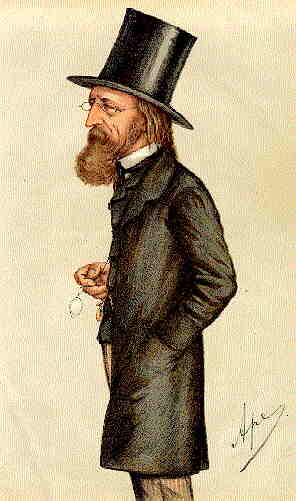The directory «Plots»
Tennyson Alfred
(1809–1892)

English poet. The most famous poet of the Victorian age, he was a profound spokesman for the ideas and values of his times.
Tennyson was the son of an intelligent but unstable clergyman in Lincolnshire. His early literary attempts included a play, The Devil and the Lady, composed at 14, and poems written with his brothers Frederick and Charles but entitled Poems by Two Brothers (1827). In his three years at Cambridge, Tennyson wrote a prizewinning poem, Timbuctoo (1829), and Poems, Chiefly Lyrical (1830) and began his close friendship with Arthur Henry Hallam, son of the historian Henry Hallam.
Upon the death of his father in 1831, Tennyson became responsible for the family and its precarious finances. His volume Poems (1832) included some of his most famous pieces, such as “The Lotus-Eaters,” “A Dream of Fair Women,” and “The Lady of Shalott.” In 1833 he was overwhelmed by the sudden death of Hallam.
Tennyson’s next published work, Poems (1842), expressed his philosophic doubts in a materialistic, increasingly scientific age and his longing for a sustaining faith. The new poems included “Locksley Hall,” “Ulysses,” “Morte d’Arthur,” and “Break, Break, Break.” With this book he was acclaimed a great poet, and in addition, he was granted an annual government pension of £200 in 1845.
The Princess (1847) was followed in 1850 by the masterful In Memoriam, an elegy sequence that records Tennyson’s years of doubt and despair after Hallam’s death and culminates in an affirmation of immortality. The same year saw his appointment as poet laureate and his marriage to Emily Sellwood, whom he had courted since 1836 but had been unable to marry because of his precarious financial position. Occasional poems, such as the “Ode on the Death of the Duke of Wellington” (1852) and “The Charge of the Light Brigade” (1855), were part of his duties as laureate.
The first group of Idylls of the King appeared in 1859; it was expanded in 1869 and 1872, and in 1885 Tennyson added the final poem. He arranged the 12 poems chronologically in 1888 to constitute a somber ethical epic of the glory and the downfall of King Arthur. In the Arthurian legend, Tennyson projected his vision of the hollowness of his own civilization. Included among his other works are Maud (1855), a “monodrama”; Enoch Arden (1864); several poetic dramas, most notably Becket (1879; produced 1893); Ballads and Other Poems (1880); and Demeter and Other Poems (1889), which contained “Crossing the Bar.”
Tennyson passed his last years in comfort. In 1883 he was created a peer and occupied a seat in the House of Lords. Throughout much of his life he was a popular as well as critical success and was venerated by the general public. Unappreciated early in the 20th cent., Tennyson has since been recognized as a great poet, notable for his mastery of technique, his superb use of sensuous language, and his profundity of thought.
Great Britain, 1992, Tennyson in 1888
Great Britain, 1992, Tennyson in 1856
Great Britain, 1992, Tennyson in 1864
Great Britain, 1992, Tennyson as Young Man
Great Britain. Staffa, 1982, Alfred Tennyson
Great Britain, 1992.03.10,  Edinburgh. Alfred Tennyson
Edinburgh. Alfred Tennyson
Great Britain, 1992.03.10,  Freshwater. Muse
Freshwater. Muse
Great Britain, 1992.03.10,  Isle of Wight. Alfred Tennyson
Isle of Wight. Alfred Tennyson
Great Britain, 1992.03.10,  Somersby & Bagenderby. Bridge
Somersby & Bagenderby. Bridge
Great Britain, 1992.03.10,  Tintagel, Cornwall. Tennyson
Tintagel, Cornwall. Tennyson